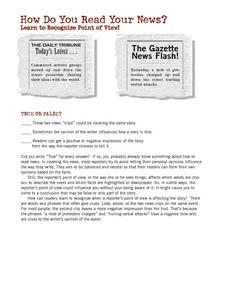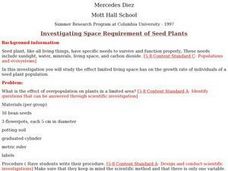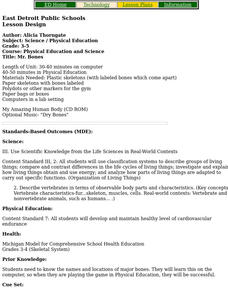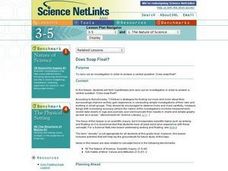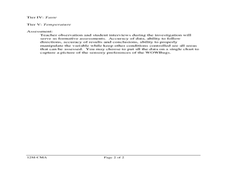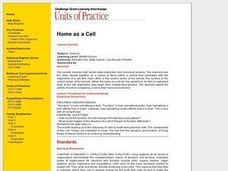Curated OER
Testing Leaves for Starch: the Technique
Like good scientists, kids often want to see first-hand why things are as they are; they can do just that in the starch-testing photosynthesis activity found here. Depending on the age of your pupils, you may wish to do the investigation...
TV411
How Do You Read Your News?
Words carry baggage. Class members are asked to consider the weight of words in an exercise that contrasts the word choices in two versions of the same event. Consider following the exercise with an activity in which pairs craft positive...
Curated OER
The Eyes Have It!
Reading essays about deep-sea expeditions open this lesson on crustacean vision. Marine biology explorers study the compound eye and then complete a worksheet in response to all they have discovered. Although the lesson doesn't offer an...
Curated OER
Gingerbread Spacecraft
Students explore the different parts of the Cassini spacecraft. In this space science lesson, students create a model of the spacecraft using food products. They compare and contrast their model with the real one and evaluate its...
Curated OER
Electricity
Focusing on what electricity is and where it comes from, the information here is accessible to young scientists. The basics of how electricity is made and its uses as a power supply are given with clear illustrations. Some examples...
K5 Learning
Susie and Rover
Reinforce reading comprehension skills with a two-page worksheet offering a story about a young girl, her dog, and an important life lesson. Scholars read the text then show what they know through four short-answer questions.
Curated OER
Investigating Space Requirement of Seed Plants
Students use scientific methods to investigate the effects of overpopulation of seed plants on growth in a limited living space. Students relate seed plant population findings to that of other organisms.
Curated OER
Viruses Quiz
For this science worksheet, students will test their knowledge of viruses. Students answer ten multiple choice questions pertaining to virus characteristics.
Curated OER
Our Classroom is a Community: LEAGUE Philanthropy Lesson
Students examine the concept of community. For this philanthropy lesson, students consider how their classroom could be considered a community and discuss how they can be philanthropists in their own classroom.
Curated OER
Circulatory and Respiratory Systems
Eighth graders are able to write a paragraph describing each system based on the information retrieved in class. They trace a route from Holly Springs, MS to Greenwood using the maps that they were given. Students discuss the role of...
Benjamin Franklin Tercentenary
Benjamin Franklin, Working for the Common Good
Young scholars examine Benjamin Franklin's community service in Philadelphia. For this American history famous heroes instructional activity, students make text-to-self-and-world connections between the Philadelphia community service...
Curated OER
Using Words to Work Things Out
Students study conflict resolution. In this conflict resolution lesson plan, students read a book about anger and watch a puppet skit about how to handle conflicts. Students create their own puppet skit about conflict resolution.
Curated OER
Ecosystems: What Are They and How Do They Work?
Students explore the characteristics of major ecosystems, the interactions of the organisms within the systems, and the effects of humans on the system. Both living and non-living components are examined in this five lesson unit.
Roald Dahl
The Twits - The Furniture Goes Up
Work gets done faster when people work as a team. The ninth installment of an 11-lesson unit designed to accompany The Twits by Roald Dahl combines character education with research skills and creative writing activities. The lesson ends...
Curated OER
Using Logic
For this using logic worksheet, students are given a variety of methods used to solve problems based on logic. They read about cause and effect relationships and finding solutions to problems. They are given three problems to solve using...
Curated OER
Microbes in Long Island Sound
Students discover the harm and benefits of microbes. In this biology lesson, students explore water, nitrogen and carbon cycles. They investigate the factors affecting bacteria growth.
Curated OER
Environmental Limitations
Seventh graders study the environmental factors that affect population growth. In this biology instructional activity, 7th graders create a city following certain criteria. They present their posters in class.
Curated OER
Mr. Bones
Students play CD-ROM game My Amazing Human Body, and participate in relay game in Phys. Ed. where they put together skeleton on which body parts are labeled.
Curated OER
Does Soap Float?
Students form hypotheses and carry out an investigation in order to answer a central question: Does soap float? The focus of this activity is on scientific inquiry, but it incorporates scientific topics such as sinking and floating.
Curated OER
Philanthropy in Your Community
Young scholars brainstorm how an action to benefit others is a type of philanthropy. They
identify the commonwealth approach to philanthropy,
plan and carry out a philanthropic action in their community and
reflect how their action...
Curated OER
Algae Part One: An Introduction
Students have the opportunity to view two types of algae under 400x magnification with a compound microscope. They make observations and record their observations through drawings and words. In addition, they identify different qualities...
Curated OER
The Nature of Science and Technology
Second graders perform a variety of experiments to observe, form conclusions, and make inferences. In this experiment lesson, 2nd graders experiment based on the result of a pre-assessment. Students share what they have learned.
Curated OER
Seed Socks
Students explore how seeds travel. In this seed disbursement lesson, students head outside in their bare socks. Students walk around then before going inside they take the socks off and examine what their socks picked up. As a class the...
Curated OER
Home as a Cell
Students correlate a series of items with the organelles of a cell. They compare the school to a cell, and create a drawing that compares the cell structure with their home.



